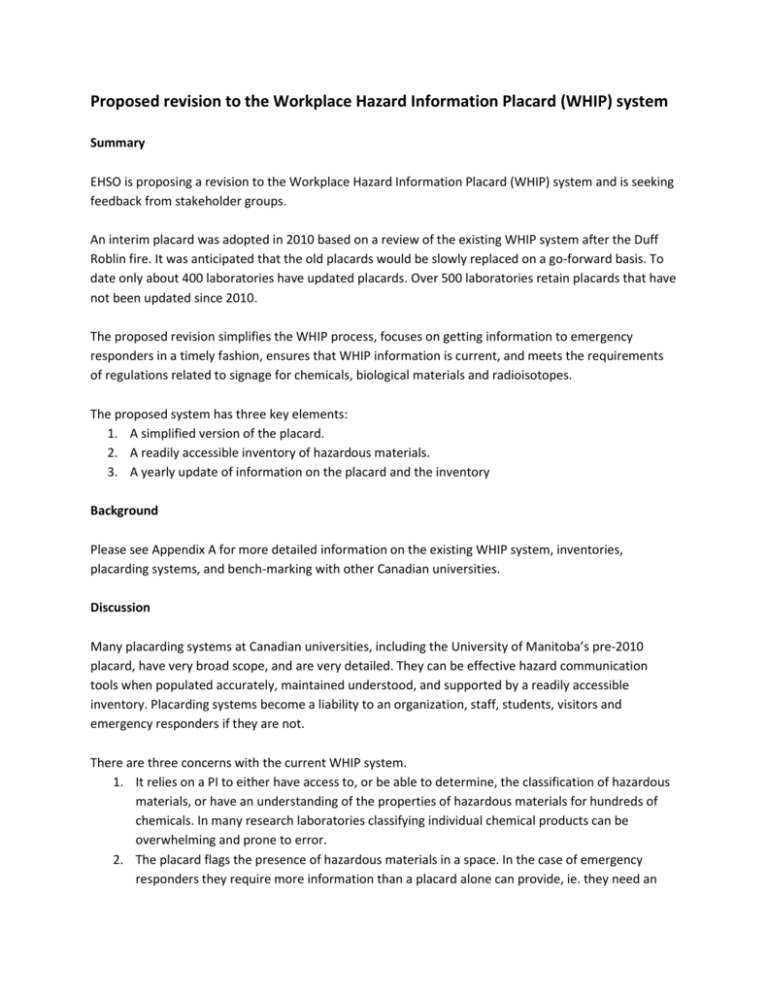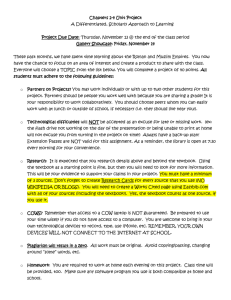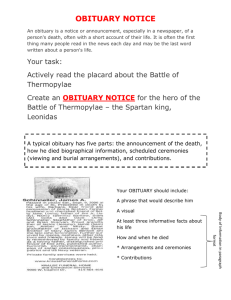Proposed revision to the WHIP system
advertisement

Proposed revision to the Workplace Hazard Information Placard (WHIP) system Summary EHSO is proposing a revision to the Workplace Hazard Information Placard (WHIP) system and is seeking feedback from stakeholder groups. An interim placard was adopted in 2010 based on a review of the existing WHIP system after the Duff Roblin fire. It was anticipated that the old placards would be slowly replaced on a go-forward basis. To date only about 400 laboratories have updated placards. Over 500 laboratories retain placards that have not been updated since 2010. The proposed revision simplifies the WHIP process, focuses on getting information to emergency responders in a timely fashion, ensures that WHIP information is current, and meets the requirements of regulations related to signage for chemicals, biological materials and radioisotopes. The proposed system has three key elements: 1. A simplified version of the placard. 2. A readily accessible inventory of hazardous materials. 3. A yearly update of information on the placard and the inventory Background Please see Appendix A for more detailed information on the existing WHIP system, inventories, placarding systems, and bench-marking with other Canadian universities. Discussion Many placarding systems at Canadian universities, including the University of Manitoba’s pre-2010 placard, have very broad scope, and are very detailed. They can be effective hazard communication tools when populated accurately, maintained understood, and supported by a readily accessible inventory. Placarding systems become a liability to an organization, staff, students, visitors and emergency responders if they are not. There are three concerns with the current WHIP system. 1. It relies on a PI to either have access to, or be able to determine, the classification of hazardous materials, or have an understanding of the properties of hazardous materials for hundreds of chemicals. In many research laboratories classifying individual chemical products can be overwhelming and prone to error. 2. The placard flags the presence of hazardous materials in a space. In the case of emergency responders they require more information than a placard alone can provide, ie. they need an inventory of hazardous materials present. Inventories may not be readily accessible to emergency responders at the University. 3. About 800 WHIP were produced between 2006 – 2010. Over 500 of these placards remain in place. The information on these placards is at least 4 years old and for some proportion would have to be considered suspect. For a more detailed summary of the EHSO review of the current WHIP system, and the pre-2010 placard, please see Appendix B. The pre-2010 placard was based on an all-hazards approach, ie. it tried to capture any potential hazard in a space from fertilizers to insects to ultraviolet light. For chemical hazards there were multiple classifications many of which were undefined. The placard went further by trying to capture maximum quantities present of each classification. This provided a lot of information that would be difficult for staff, students, or visitors to interpret in any way – other than that hazardous materials were present. The placard could not provide all the information required by emergency responders. The interim placard stepped away from much of the complexity associated with the pre-2010 placard. Part of that simplification was to limit the placard to deal with chemical, and biological, substances as well as radioisotopes. It does not attempt to incorporate warnings for: Devices producing ionizing or non-ionizing radiation, eg. lasers, x-ray units. High voltage Insects Noise Magnetic fields Note that some of these hazards have very prescriptive labeling requirements under Manitoba legislation that could not be accommodated in the WHIP system, eg. lasers. In these cases labeling appropriate to the specific hazard should be used. The interim placard did not adopt WHMIS, TDG or NFPA hazard symbol systems. Each system created the same issue that the pre-2010 placard created in that they would require attempts to classify hundreds of chemicals. The interim placard does not include any indication of quantities present. This was to be captured in a printed inventory located in a readily-accessible location away from the laboratory. The Proposed WHIP System EHSO staff based the proposed WHIP system on the following criteria. The system must : Comply with regulatory requirements for signage related to hazardous materials Use readily understood symbols to designate hazards Be realistic and sustainable in terms of resources required to produce and maintain the placards Provide emergency responders with useful and timely information when responding Provide accurate information for anyone viewing the placard or attempting to use it Act as a flag to anyone entering a laboratory that there are hazardous materials inside The proposed WHIP system has three key elements: 1. A placard to be placed at the entrance to a laboratory 2. A printed inventory readily accessible to emergency responders 3. A system for the regular updating of information associated with the placard Each part is discussed separately below. The proposed placard The proposed placard is compliant with regulatory requirements associated with chemicals, biological materials and radioisotopes. See Figure 1 below for an example of the proposed WHIP. Figure 1. The proposed placard The proposed placard uses three hazard symbols that are understood by emergency responders 1. The TDG Danger symbol required by the Manitoba Fire Code for rooms with multiple chemicals present. Since the symbol would not be familiar to students and most staff the word “Chemicals” has been added. 2. The biohazard symbol including containment level as required by the recently released Canadian Biosafety Standards and Guidelines. Note that Containment Level 1 (CL1) laboratories no longer require biohazard signage. The proposed placard will still indicate that a space is CL1 but will not display the biohazard symbol. 3. Radioisotope symbols: a) The radiation trefoil when required by the Canadian Nuclear Safety Commission (CNSC) or; b) An icon designating the space as a radioisotope permitted space when the trefoil may not be displayed Use of these symbols does not generally require classification of individual compounds by PI’s, or their designates, and should greatly simplify the placard production process while still providing important information and complying with regulatory requirements. The proposed placard retains some content, adds some new elements and removes some content from the interim placard. Each is discussed below Retained content The proposed placard retains much of the information contained on the current interim placard. Retained content includes: Building name Room number “Authorized personnel only” notification Hazardous products identification Icons for radioisotopes, biological materials and chemicals as applicable Emergency contacts* Name Telephone Office number After hours contact for Security Services Nearest first aid kit location Date prepared EHSO contact for laboratory signage information * Note that Security Services has been given access to EHSA to view room placards and to access emergency contact information. At this point that data is limited to information associated with interim placards, ie. it is available for only about 40% of laboratory spaces. EHSA will be used as the central database for emergency contact information for laboratories to ensure easy access by Security Services. New content/approaches “Special conditions” is a new space added to the placard. This box allows users to account for situations that occur infrequently and are difficult to incorporate into the placard template for general use. For example, PPE requirements to enter the space (as opposed to PPE requirements to work in the space), entry restrictions, special hazards, etc. This approach lets us comply with requirements in the Canadian Biosafety Standards and Guidelines Restricted spaces. Radioisotope laboratories with restricted access will have an additional placard to meet CNSC labeling requirements in addition to the placard. This will affect a very limited number of laboratory spaces (< 1 % of all laboratories on campus). Emergency contacts. Anyone listed as an emergency contact on a placard must be able to provide information to emergency responders, and to others wanting to enter the space, for all hazards indicated on the placard. Reversible placard. CNSC restricts the times when the trefoil can be displayed on a laboratory door. Where these conditions are not met an icon that is distinct from the trefoil will be used to show that the space is a radioisotope permitted space. In these instances the placard will be printed in a two-sided format with one side displaying the trefoil and the other displaying the radioisotope permitted icon. The placard can then simply be reversed to comply with CNSC restrictions. Hard copy inventory location. A placard is of limited use for an emergency responder if there is no information available on the actual contents of the space. Keeping this information in the laboratory is also not helpful since it would require entering the space to retrieve the information to assess the space. Likewise having the information in a database/spreadsheet that cannot be readily accessed is of no use. At this time a printed inventory kept outside the laboratory remains the best way to ensure that emergency responders can access the information that they require. Content to be removed “Entrance requirements; No FOOD or DRINK”. This information is not required content for laboratory signage and could be standard procedure for all laboratories and should be incorporated into laboratory safety training/orientation. “PPE” icons have been removed and replaced with the “Special precautions” section. Use of icons to indicate PPE requirements adds complication, and in some cases confusion, because many do not reflect entrance requirements but instead requirements for performing specific tasks in the space. Full shoes should be a standard requirement for anyone in a laboratory and should be incorporated into laboratory safety training/orientation. Other “commonly used” PPE is usually associated with some procedure or task. These requirements for task specific PPE should be captured in laboratory safe work procedures and training rather than on an entrance placard. “MSDS location”. It is reasonable to assume that MSDS are in the laboratory or that the PI can direct a student/tech to the source for MSDS. This can be covered in laboratory safety training and/or orientation rather than appearing on the placard. Prepared by. In terms of someone entering a space this information adds nothing. The information is captured in the WHIP application and available that way if needed. Inventory The Province eliminated a specific requirement for documented chemical inventories in 2006. Despite this due diligence requires that we know which hazardous materials are present in our laboratories. Emergency responders need a readily available inventory of the hazardous materials present in a space to plan their response. Although it seems like a backwards step, a printed inventory, located in a space away from the laboratory, is the simplest way to achieve this. The inventory is then readily accessible to emergency responders. The inventory needs to reflect the hazardous materials present in a space. To do this the proposed WHIP system calls for inventories to be revised on a yearly basis. The inventory is a snapshot of what is present in the space at the time of the update. A sample inventory is shown in Figure 2 below. Figure 2. Sample inventory for a laboratory with no radioisotopes or biological materials. The inventory will require only three pieces of information for each hazard class. That information is related to the clear identification of the substance and some indication of the quantities present for radioisotopes and chemicals. Annual updates would be a minimum requirement. PI’s would be encouraged to updated inventories when significant changes occur in inventories, eg. addition of toxic or flammable gas cylinders. Note that for biological materials updates are required within 30 days. The printed version of the inventory can be produced through the Environmental Health and Safety Assistant (EHSA) database or be captured in an Excel spreadsheet. To assist first responders the inventory list would be broken into 3 parts: 1. Radioisotopes 2. Biological substances 3. Chemical substances Permits already require inventories of biological materials and radioisotopes. This data can be copied to the inventory list and edited as needed (radioisotopes and biological materials in EHSA are associated with a PI rather than a particular space). The chemical substances list would be broken into 3 sections to assist emergency responders in assessing the level of hazard associated with a space: 1. Compressed gases 2. Substances present in quantities over 1 litre or 1 kilogram 3. All other chemicals The intent would be to quickly identify for emergency responders substances present in larger amounts as opposed to mixing these in with substances present in small quantities. If the proposed WHIP system were to be adopted EHSO would begin a program of installing secure boxes beside building fire panels to house hard copy inventories. Annual updates of WHIP information The intention is that EHSO would continue to produce placards for the immediate future. Out of date information associated with a placard, eg. emergency contact information, or the PI responsible for a space, creates the potential for delays in responding to any situation associated with a space from a fire to a water leak to a refrigerator alarm. EHSO cannot police this in a sustainable fashion. The proposed WHIP system would call for PI’s responsible for a space to notify EHSO of significant changes associated with WHIP information for that space as quickly as possible. Significant changes would include changes in contacts, or contact information for the space, or notification that the space is no longer associated with a PI. At minimum WHIP information would be reviewed on an annual basis. The review would be triggered by a brief questionnaire sent out by EHSO to all PI’s associated with placarded spaces. The document would simply require verification that placard data is correct and any required updates. Summary The proposed WHIP system meets the criteria suggested by EHSO. It should: Meet all regulatory requirements Greatly simplify production of placards Create a formal system to ensure WHIP information is up to date Ensure that delays associated with response to emergencies is minimized Appendix A Background information on the WHIP system Introduction The WHIP system was introduced in 2006. The intention was to create an “all hazards” placard for spaces using, or storing, hazardous materials. Figure 1 shows an example of this placard. Figure 1. Placard content prior to March 2010. The primary focus of the WHIP system was laboratories although there was some intention that it should be used on all spaces with hazardous materials present. The system required PI’s or other laboratory staff to review safety data for all hazardous materials present and classify each material. The WHIP system offered 27 different icons to categorize primarily chemical hazards. Updates for these placards and associated information, particularly for laboratories with chemical hazards, were not done on any formal basis. There was an intention that EHSO staff would monitor updates but resource issues limited the effectiveness of this approach. The WHIP system was reviewed in early 2010 as a result of concerns raised after the Duff Roblin fire. The system did not appear to be sustainable, or effective, in some cases. For a more detailed review see Appendix B. In March 2010 production of the existing placard was stopped. An interim placard was developed that addressed compliance requirements for hazard posting pending proposal and adoption of a new WHIP system. The Interim Placard The interim placard was produced for any new or updated WHIP application after March, 2010. PI’s could choose to retain an existing placard if they were confident that it accurately reflected laboratory contents and associated information. Interim placards were to be associated with a hard copy inventory in a location remote from the laboratory. Figure 2 below provides an example of the interim placard. Figure 2. An example of an interim placard for a laboratory with only biological materials and chemicals. This placard is simplified and eliminates the use of 27 possible icons to denote hazards and drops to 3 icons: 1. TDG “Danger” icon to denote the presence of a mixture of chemicals as required by the Manitoba Fire Code. 2. Biohazard symbol (with containment level). 3. The trefoil for spaces using radioisotopes. The interim placard also removed any indications of quantities of materials present. This was to be captured in the hard copy inventory. Inventories Inventories provide critical information to emergency responders as they prepare to respond to an event. Without an up to date inventory a placard alone is of limited value. For radioisotopes and biological materials up to date inventories are requirement of permits and/or approvals. Inventory concerns are associated with chemicals. In 1988 the Province created a regulation that was very prescriptive in terms of chemical inventory record-keeping. The Environmental Health and Safety Assistant (EHSA) database was being used to record inventories of radioisotopes and was proposed as a means of recording chemical inventories. Its use was seen as cumbersome and many PI’s and some faculties rejected it. At this point less than 1/3 of spaces with WHIP have any inventory associated with them. It is unclear how many of these inventories have been updated. In 2007 a revision of Manitoba health and safety regulations saw the requirement for inventories disappear. There was no change to the WHIP system to reflect that an important element of the system was no longer required. Despite the lack of a direct regulatory requirement for inventories due diligence would require that we know what hazardous materials were present in University laboratories. In 2010 applications for the interim WHIP called for PI’s to make a printed copy of their inventory to be accessible in a location remote from the laboratory, eg. administrative offices. In 2011 the entry process for inventories into EHSA was simplified but there was very little response to the change. It is unknown how many laboratories have chosen to maintain up to date inventories or how accessible those inventories would be in the event of an emergency. Placarding systems There are three standardized systems commonly used to indicate the types of hazardous materials present in a particular location. All three are familiar to emergency responders. Two are based on existing Canadian regulations: Workplace Hazardous Materials Information System (WHMIS) Transportation of Dangerous Goods (TDG) The third is known as the Nation Fire Protection Association (NFPA) hazard diamond. The system is based on NFPA Standard 704 which is not accessible without purchase. For a helpful summary on the NFPA hazard diamond please visit http://www.ehs.neu.edu/laboratoryoratory_safety/general_information/nfpa_hazard_rating/ The NFPA diamond breaks hazards into four general categories: 1. Health 2. Flammability 3. Reactivity 4. Special information, eg. water reactive Ratings for many individual compounds are available. Other Universities In considering systems that might replace the existing WHIP EHSO reviewed placard systems used at universities & colleges across Canada. We were able to discuss or view WHIP systems for 11 Canadian universities and colleges (see Appendix C for the list). Most system were not dissimilar to the University’s pre-2010 system. Many incorporated a mixture of symbols (WHMIS, TDG, NFPA) with in-house symbols. Most required that hazardous substances be classified and some included quantities present. Many attempted to deal with all hazards. To view systems used at other Canadian universities please view a PowerPoint presentation posted at LINK. Appendix B EHSO review of pre-2010 WHIP In 2010, EHSO reviewed the WHIP system and determined that that there were significant concerns with it. These included: The icons used on the placard were taken from a mixture of labeling systems. Some were taken from Transportation of Dangerous Goods (TDG). Others were taken from the Workplace Hazardous Materials Information System (WHMIS). There were also icons that were unique to the University of Manitoba. The issue was that first responders in particular, and others, were not trained on the meaning of the unique University icons. PI’s, or others in laboratories, were expected to review safety data and classify all hazardous materials present in a laboratory. This would be an overwhelming task in many laboratories because: There could be hundreds of chemicals present There were no definitions for the classifications unique to the University WHMIS classification data is not required to appear on material safety data sheets (MSDS) and may not be readily accessible. Many substances meet the criteria for more than one hazard class making it difficult to determine a single classification for a material, or resulting in counting a single substance multiple times. The placard was to be supported by a current inventory of hazardous materials in the laboratory that would be accessible. There is uncertainty about how many inventories have been maintained and how many would be accessible in the event of an emergency. Without them the placard alone would be of minimal assistance. Emergency contact information and other information associated with the placard was not being regularly updated. About 600 placards were produced prior to 2010 that have not been replaced with the interim placard. The information on these placards is now 5 years old and has to be considered suspect. The PPE icons on the WHIP Created significant confusion for individuals not familiar with a particular laboratory. For example, caretaking staff and contractors were uncertain whether they required a laboratory coat to simply enter the space. Were used inconsistently. “Commonly used” PPE items did not provide helpful information to persons entering the laboratory since in many cases they were only required for specific tasks within the laboratory. The placard attempted to provide detailed hazard information to all parties that might enter a space. The level of detail provided was generally not useful to most users of the laboratory. Appendix C Canadian universities and colleges used for benchmarking WHIP systems Over 50 Canadian universities and colleges were contacted. The bench-marking was based on direct contact with the university or college, or information accessible on their website. We were able to look at 12 systems. Lakehead University Queens Simon Fraser University St. Mary’s University University of: British Columbia Calgary Regina Saskatchewan Waterloo Windsor Winnipeg York University






